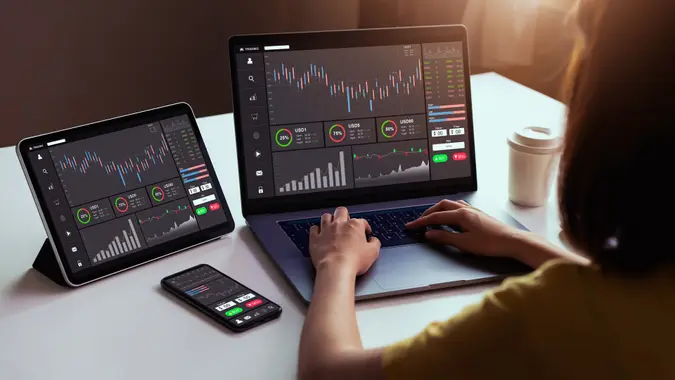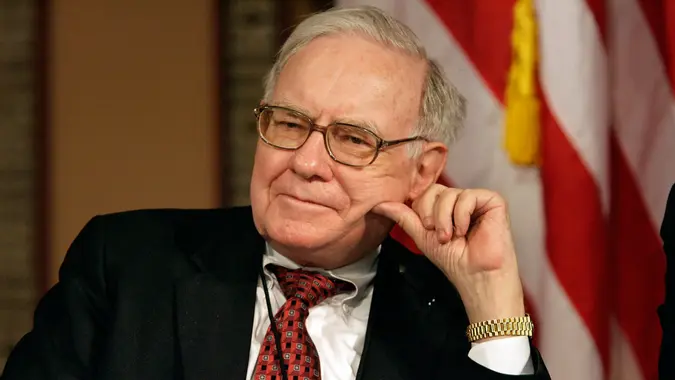Why Is Crypto So Volatile?

Commitment to Our Readers
GOBankingRates' editorial team is committed to bringing you unbiased reviews and information. We use data-driven methodologies to evaluate financial products and services - our reviews and ratings are not influenced by advertisers. You can read more about our editorial guidelines and our products and services review methodology.

20 Years
Helping You Live Richer

Reviewed
by Experts

Trusted by
Millions of Readers
It has been an unpredictable year for crypto investors. After Bitcoin’s value accelerated by 300% in 2020 and reached an all-time high in April 2021, crypto trading volume on popular exchanges like Coinbase, Binance, Kraken and Bitstamp fell more than 40% in June. The price of Bitcoin found a new floor at $28,908.
Some analysts point to China’s recent attempt to crack down on cryptocurrency trading as a possible reason for crypto’s bumpy transition from spring to summer in 2021. Others consider crypto to be volatile for a number of reasons — from an overall lack of centralization to the recent controversy around the environmental impact of mining coins and supporting digital transactions on a large scale.
Regardless of the reason for crypto’s long-standing reputation for instability and ongoing turbulence, investors — especially those who have yet to dip their toes in — deserve to know what crypto’s volatility is all about, why crypto crashes and what it means for their portfolios.
What Volatility Means to Investors
When it comes to putting money anywhere but the bank, many people fear the potential ups and downs — in other words, the volatility that their investments may experience.
In basic terms, volatility is described as regular up-and-down movement in the value of an asset. That asset competes with its own average, meaning that an asset’s current up or down movement is judged against its average up or down trend line.
Is Volatility a Bad Thing?
Collectively, the world has come to understand the costs of volatility. People know what a market crash looks and feels like. More recently, everyone saw what can happen if a group of investors decides to target a single stock. Investors have learned over and over again to guard against volatility — so regulation is a constant.
It’s that regulatory work aimed at curbing volatility that makes cryptocurrency so attractive. Investors willing to take risks can do well with crypto if they’re willing to tolerate regular ups and downs.
So while a traditional investor might prefer a slow and steady rate of return on investments, a crypto investor might embrace swings in the pursuit of big returns. Volatility can be the enemy for one investor and the source of hope for another — so as crypto becomes more common, conversations around volatility are becoming more complex.
Why Is Crypto So Volatile?
There are several reasons why crypto tends to both soar and crash. See below for a closer look.
1. Decentralization
Technically, anyone can mine for coins. This means that one of crypto’s key features — decentralization — also makes for a trading environment full of unknown buyers and sellers.
2. Lack of a Tether
Traditional investments, such as company stock and diversified funds, are valued based on the companies they’re attached to. Cryptocurrency, in comparison, is not backed by a government or a commodity like gold or silver. Its value is what the crypto trading community decides it is.
3. Investor Confidence (or Lack Thereof)
Since crypto coins can be mined by anyone with the technology and know-how and they aren’t backed by the standard tools used to assign value to money, investors can find it hard to trust in them.
4. Limited (If Any) Oversight
As crypto becomes more popular and investment firms begin to embrace it, there’s a slow march toward regulation in the space. As regulation efforts evolve, however, crypto remains a fairly unencumbered arena for those who want to lean into volatility in hopes of catching an above-average upside.
5. Security Issues
Due to the pricing highs that the cryptocurrency market can experience, crypto assets are sitting ducks for theft. From the hacking of digital transactions to fake currency exchanges and investment websites claiming to sell the currency, crypto theft is up nearly 1,000% year over year.
6. Controversy
Crypto faces scrutiny for its impact on the environment due to the energy consumption and physical servers needed to support coin mining, digital storage and a high volume of transactions. Although the industry is rapidly trying to lower its emissions, much work remains to be done.
7. Minimal Insurance
Although insurers appear to have a significant opportunity in the cryptocurrency market, current options for insuring assets are limited.
Crypto exchanges have the option to hold coins in hot storage, which is connected to the internet, or cold storage, which is not (for example, in a safe). However, even a large crypto exchange like Coinbase is believed to keep about 2% of its coins with Lloyd’s of London.
8. Multistep Exit Process
When you decide to exit a cryptocurrency investment, you may need to follow multiple steps. The process varies by where you store your crypto and whether you must first transfer it to an exchange.
9. Struggle for Widespread Adoption
Merchants and governments alike are struggling to back crypto. Tesla’s CEO, Elon Musk, recently announced that the vehicle manufacturer would no longer accept Bitcoin as payment for its automobiles, later saying he would reverse course as crypto becomes more environmentally friendly. On a larger scale, China has made new efforts to crack down.
Good To Know
There’s a growing desire for stability in the crypto market, and there’s a coin for that. The stablecoin is a new type of cryptocurrency backed by a reserve asset, such as the U.S. dollar or the price of gold. As the backing commodity is bought or sold, the stablecoin’s value goes up or down accordingly.
Mitigating Risk in a Risk-Prone Market
There are many reasons for crypto’s volatility — and much uncertainty about if or how the crypto market will take further steps toward regulation, insurability, security and stability.
For now, investors interested in cryptocurrency should know that they are their own best asset. The wise approach is to do research, track investment performance and base any choices on an overall portfolio strategy — rather than getting lost in the stress and uncertainty of frequent market upturns and downturns.
Our in-house research team and on-site financial experts work together to create content that’s accurate, impartial, and up to date. We fact-check every single statistic, quote and fact using trusted primary resources to make sure the information we provide is correct. You can learn more about GOBankingRates’ processes and standards in our editorial policy.
- Federal Trade Commission. 2021. "Cryptocurrency buzz drives record investment scam losses."
- CNBC. 2021. "Cryptocurrency trading volume plunges as interest wanes following bitcoin price drop."
- CNBC. 2021. "China’s war on bitcoin just hit a new level with its latest crypto crackdown."
- USA Today. 2021. "Bitcoin briefly crashed again, wiping out 2021 gains. Here's why."
- The New Yorker. 2021. "Why Bitcoin Is Bad for the Environment."
- CoinMetro. "How Long Does it Take to Transfer Bitcoin to Your Bank Account?"
- CNN Business. 2021. "Bitcoin jumps as Elon Musk suggests way that Tesla could start accepting it again."
 Written by
Written by  Edited by
Edited by 

























